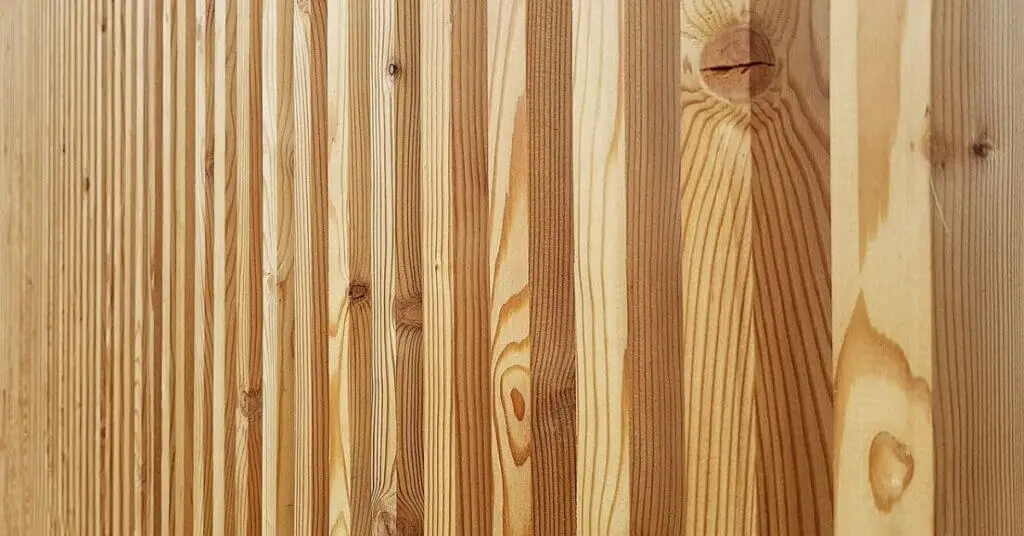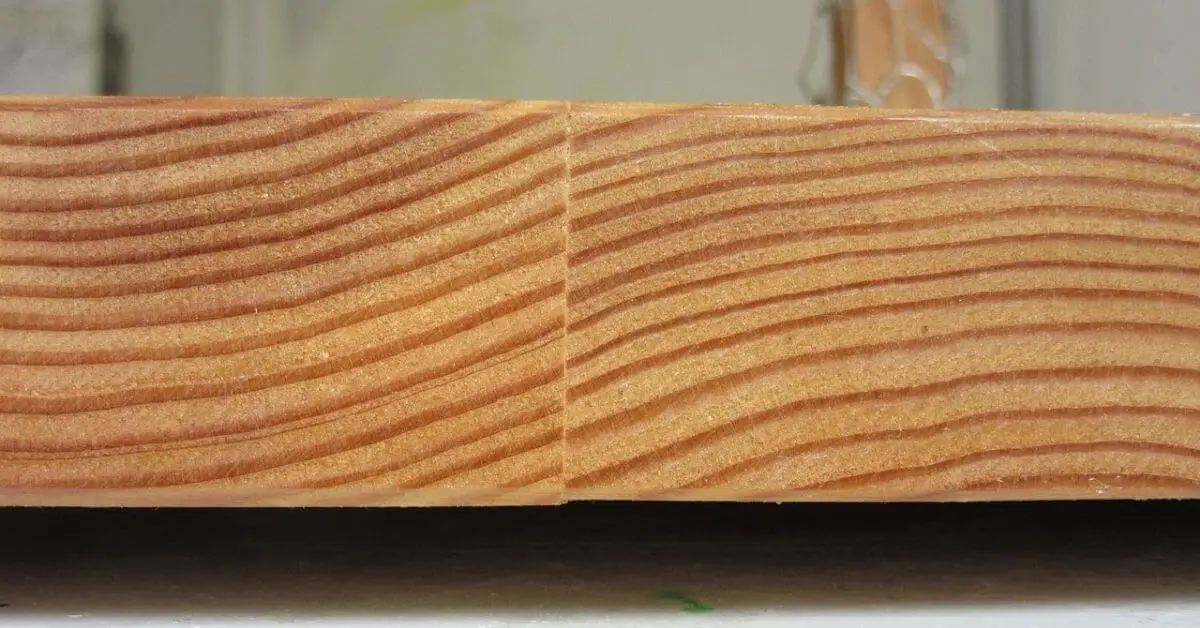What is Larch Wood?
Larch wood comes from the coniferous trees of the genus Larix, which belong to the pine family (Pinaceae). There are between 10 to 12 species of larch, all native to the colder regions of the Northern Hemisphere. Unlike most conifers, which are evergreen, larch trees are deciduous, meaning they lose their needles in autumn.
Larch wood is widely recognized for its durability, toughness, and water-resistant properties. It’s often used in applications where these characteristics are essential, such as boats, gazebos, siding, flooring, and fencing.
Although classified as a softwood, larch wood boasts a natural resistance to rot, making it suitable for both interior and exterior projects.
| # | Larch Wood |
| Scientific name | Larix |
| Tree | 20 to 45 m (65 to 150 ft) tall, .6-1 m (2-3 ft ) trunk diameter |
| Rot resistance | Resistant to rot |
| Water-resistant | Good |
| Workability | Good |
| Color/Appearance | Pale creamy white |
| Type | Softwood |
| Uses | Floors, siding, boats, etc |
What is Larch Wood Used For?
1. Flooring
Larch wood is an attractive, durable, and cost-effective option for flooring. Its light color, which ranges from yellow to medium reddish-brown, makes it easy to stain and customize to your desired aesthetic. Despite being a softwood, it offers excellent resistance to both water and rot, making it a great choice for high-traffic areas.
To preserve the natural grain and beauty of larch flooring, regular maintenance, such as staining and polishing, is recommended.
2. Siding
Larch wood is widely used for building siding, particularly in regions where buildings are exposed to harsh weather conditions. Its high density and oily surface prevent moisture from penetrating, which helps protect homes from rain, snow, and sun damage.
Siberian Larch, in particular, is a popular choice across Europe for both siding and decking due to its strength and weather resistance.
3. Boat Construction
Thanks to its long, straight wood veins and excellent bending properties, larch wood is a preferred material for boatbuilding. It’s lighter than many other woods but strong enough to withstand the wear and tear of water exposure. Its resistance to rot and moisture further adds to its appeal for crafting hull planks and other boat parts.
The appearance of Larch Lumber

Larch wood varies in color from pale creamy white to reddish-brown, with a distinct dark-striped or grainy pattern. The sapwood is typically lighter, almost white, compared to the heartwood. The natural grain patterns of larch are highly visible and often enhanced by small knots, which give the wood a unique and rustic aesthetic.
Larch Wood Advantages and Disadvantages
Advantages
- Appearance: It has a great medium reddish-brown to light beautiful appearance.
- Easy to stain: Due to the light color, it can be stained easily.
- Rot Resistant: Moderately durable regarding decay resistance.
- Workability: Due to low density, it can be easily worked with hand tools and machines. Sometimes the work can be difficult due to the spiraled grain pattern and knots. But glues and finishes well.
- Small knots: Knots are common but are usually small.
- More options: We get the option of many colors and grain patterns in larch.
- Insect Resistant: The larch wood has natural insect-resistant properties.
- Stability: Shrinkage in drying is fairly low.
- Drying: The wood dries fairly easily, with some warp and checking.
Disadvantages
- Allergies and Toxicity: Larch has been reported to cause skin irritation, as well as hives and skin lesions.
- Odor: European Larch can have a distinct resinous odor when being worked.
- Price: It can be expensive compared to some softwoods like spruce.
Types of larch wood
Western Larch Wood
Western Larch is a famous species of Larch. Its heartwood is yellow to reddish-brown and narrow sapwood is yellowish-white, sapwood is clearly demarcated from the heartwood.
Western Larch wood has straight grain and texture is medium to coarse with a greasy or oily feel. The wood is tough and durable, but it can be bent easily. It is suitable for indoor and outdoor uses.
It is moderately durable regarding decay resistance. So no need to take much care.
| # | Western Larch Wood |
| Scientific Name: | Larix occidentalis |
| Native to: | Northwestern North America and southwestern Alberta |
| Tree: | 30 to 60 meters (98 to 197 feet) tall, with a trunk up to 1.5 m (4 ft 11 in) diameter |
| Janka Hardness: | 830 lbf (3,690 N) |
| Uses: | Veneer, plywood, paper (pulpwood), particleboard, glue-laminated beams, construction lumber, and flooring. |
European Larch Wood
European Larch is another famous species of Larch. Its heartwood is yellow to reddish-brown and the narrow sapwood is close white and is clearly demarcated from the heartwood.
Generally, European Larch has a straight grain. It contains natural oil, which makes the surface look oily.
The wood is tough, durable, and decay-resistant. Hence it is used for exterior and interior applications.
Being soft and low density, Easily worked with hand tools and machines and can also be easily bent. Lumps are common but usually small.
| # | European Larch |
| Scientific Name: | Larix decidua |
| Native to: | Mountains of central Europe |
| Tree: | 25–45 m tall, with a trunk up to 1 m diameter. |
| Janka Hardness: | 740 lbf (3,290 N) |
| Uses: | Veneer, utility poles, fence posts, flooring, boatbuilding, and construction lumber. |
Japanese Larch Wood
Japanese Larch is native to Japan. Its heartwood is yellow to a reddish-brown and the sapwood is nearly white. Sapwood is clearly demarcated from Heartwood.
Japanese Larch has a straight grain and medium texture. The surface is oily due to the presence of natural oil. Due to this natural oil, it is moderate rot resistant. So it can be used for exterior and interior applications with low maintenance.
The workability of Japanese Larch is very good. Most hand and machine operations produce good results. sanding can create dips and uneven surfaces. Glues and finishes well.
| # | Japanese Larch |
| Scientific Name: | Larix kaempferi |
| Native to: | Japan, in the mountains of Chubu and Kantō regions in central Honshū |
| Tree: | 20–40 m tall, with a trunk up to 1 m diameter. |
| Janka Hardness: | 600 lbf (2,670 N) |
| Uses: | Utility poles, fence posts, boat building, decking, furniture, and construction lumber. |
Siberian Larch Wood
Siberian larch is commonly known as Russian larch. Its heartwood is yellow-brown to brown and sapwood is close to white. It is a coniferous tree, so The male and female cones are borne separately on the same tree.
Like other larch species, its grain is also straight. Sometimes there may be irregular grain.
The density of Siberian larch is higher than other larch species. Therefore it can be a little difficult to work with small hand tools.
| # | Siberian Larch |
| Scientific Name: | Larix sibirica |
| Native to: | western Russia |
| Tree: | 20–50 m tall, with a trunk up to 1 m diameter. |
| Janka Hardness: | 1,100lbf (4,893 N) |
| Uses: | Decking, cladding, and exterior joinery projects |
Tamarack wood
Tamarack, commonly known as the Eastern Larch, Black Larch, Red Larch, or American Larch. The length of the Tamarack tree is not very long.
The heartwood is yellow to a medium orangish-brown and the sapwood is nearly white and is clearly demarcated from the heartwood. It has a straight grain with a fine texture. It contains natural oil, which makes the surface look oily.
Tamarack is Moderately durable regarding decay resistance. Therefore it is useful for interior and exterior use.
Due to the low density, it is easy to work with hand tools and machine operations.
| # | Tamarack Larch |
| Scientific Name: | Larix laricina |
| Native to: | Canada and the northeastern United States |
| Tree: | 10–20 m (33–66 ft) tall, with a trunk up to 60 cm (24 in) diameter. |
| Janka Hardness: | 590 lbf (2,620 N) |
| Uses: | Snowshoes, utility poles, posts, rough lumber, boxes/crates, and paper (pulpwood). |
Larch Tree Identification
Tree: A healthy larch tree can reach 50 to 60 m (165 to 195 ft) and 85-150 ft (25-45 m) tall, 1-1.5 m trunk diameter.
Leaves: Larch has coniferous needles. Leaves are typically 10 to 50 cm (4 to 20 in) long, and in dense clusters of 20–50 needles on short shoots. Turn yellow before falling to the ground.
Bark: The bark on young trees is light brown and scaly. While the bark of the old tree is brown in color, with deep cracks.
Conclusion
Larch wood offers a unique combination of durability, water resistance, and aesthetic appeal, making it a popular choice for various applications from flooring to boatbuilding. Whether you’re looking for rot-resistant wood for outdoor projects or beautiful grain for interior design, larch provides plenty of versatility. However, potential drawbacks such as its price and possible allergic reactions should be considered before choosing it for your next project.
FAQs
Is larch wood good for outdoor use?
Yes, larch wood is naturally resistant to rot and water, making it ideal for outdoor applications like decking, siding, and fencing.
Can larch wood be stained?
Absolutely! Larch wood’s light color makes it very easy to stain, allowing you to customize its appearance.
Is larch wood durable?
Yes, despite being a softwood, larch is highly durable and resistant to both decay and insects.
Does larch wood require special maintenance?
Larch wood benefits from regular maintenance such as staining or polishing, especially if used for flooring or exterior purposes.
How expensive is larch wood compared to other woods?
Larch can be more expensive than other softwoods like spruce, but its durability and resistance to rot make it a valuable investment.


Comments are closed.